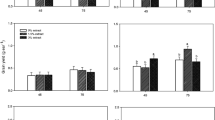Abstract
The effects of different concentrations of various macroelements on growth and endogenous GAs levels in root, stem, and leaf tissue of maize plants (Zea mays L.) were studied. Plants were cultivated in sand and supplied twice a week with a nutrient solution containing optimum, excessive, or deficient concentrations of nitrogen, phosphorus, potassium, calcium, magnesium, sulfur, and iron. Plants were harvested from three different periods: vegetation (4–5 leaves), flowering, and fruiting. The levels of gibberellic acid-like substances (GA3 equivalents ng g-1 FW) were determined by using high-performance liquid chromatography (HPLC).
In the first period (vegetative; 4–5 leaves), the levels of GAs in root, stem, and leaf of maize plants treated with excessive concentration of N, P, and Mg were increased between 6% and 27%. In the second period (flowering), significant increase was not observed in the levels of GAs, whereas a decrease was determined between 8% and 35%. In the third period (fruiting), the levels of GAs were lower (between 11% and 76%) than control plants in all applications.
Similar content being viewed by others
Literature Cited
Amzallag, G. N., H. R. Lerner, andA. Poljakoff-Mayer. 1992. Interaction between mineral nutrients, cytokinin and gibberellic acid during growth ofSorghum at high NaCl salinity. Journal of Experimental Botany 43:81–87.
Aydemir, O., andF. Ince. 1988. Bitki Besleme, Dicle Univ. Eğitm. Fak. Yayinlari, Diyarbakir.
Battal, P., andB. Tileklioğlu. 2001. The effects of different mineral nutrients on the levels of cytokinins in maize (Zea mays L.). Turkish Journal of Botany 25:123–130.
Bielski, R. L. 1968. Effect of phosphorus deficiency on levels of phosphorus compounds inSpirodela. Plant Physiology 43:1300–1309.
Chen, J.C., S. H. Cheng, Cao. Weixing, andZ. Xie. 1998. Involvement of endogenous plant hormones in the effect of mixed nitrogen source on growth and tillering of wheat. Journal of Plant Nutrition 21:87–97.
Coleman, R. G. 1957. The effect of sulphur deficiency on the free amino acids of some plants. Australian Journal of Biological Science 10:50–55.
Darral, N. M., andP. F. Wareing. 1981. The effect of nitrogen nutrition on cytokinin activity and free amino acids inBetula pendula Roth, andAcer pseudoplatanus L. Journal of Experimental Botany 32:369–379.
Duisberg, P. C., andT. F. Buehrer. 1954. Effect of ammonium and its oxidation products on rate of nitrification and plant growth. Soil Science 78:37–44.
Eaton, S. V. 1950. Effect of phosphorus deficiency on growth and metabolism of soybean. Botany Gazette 111:426–435.
FAO. 1984. Fertilizer and plant nutrition bulletin 9. Food and Agriculture Organisation of The United Nations, Roma.
Galleago, P., N. J. Hernandez, L. Martin, G. Nicolas, andN. Villolobas N. 1991. Cytokinin levels during the germination and seedling growth ofCicer arietinum L. Effect of exogenous application of calcium and cytokinins. Plant Science 77:207–221.
Hartt, C. E. 1969. Effects of potassium deficiency upon translocation of C-14 in attached blades and entire plants of sugarcane. Plant Physiology 44: 1461–1466.
Jeschke, W. D., W. Hartung, and O. Gasparikova. 2000. Root-shoot interactions in mineral nutrition. Pages 57–69 in M. Ciamporova, I. Mistrik, and F. Baluska, eds., Recent advances of plant root structure and function. Proceedings of the 5th International Symposium on Structure and Function of Roots, 31 August-3 September 1998. Stoa Lensna, Slovakia.
Kashihard, A., andH. Marshner. 1974. Iron nutrition of sunflower and corn plants in mono and mixed culture. Plant and Soil 41:91–102.
Kirkby, E. A., andA. D. Hughes. 1970. Some aspects of ammonium and nitrate nutrition in plant metabolism. Pages 69–72 in E. A. Kirkby, ed., Nitrogen nutrition of the plant. University of Leeds Press, Leeds.
Kuiper, D., P. J. C. Kuiper, H. Lambers, J. Schuit, andM. Staal. 1989. Cytokinin concentration in relation to mineral nutrition and benzyl adenine treatment inPlantago major ssp. pleiosperma. Physiologia Plantarum 75:511–517.
Kuraishi, S., K. Tasaki, N. Sakurai, andK. Sadatoku. 1991. Changes in levels of cytokinins in etiolated squash seedlings after illumination. Plant Cell Physiology 32:585–591.
Liya, S. M., A. A. Agboola, C. T. I. Odu, and S. M. Mpepereki. 1998. Feedback inhibition of nitrogen fixation by plant and environmental factors. Pages 12–17, 55–65 in F. T. Markonese, ed., Harnessing biological nitrogen fixation in Africa. International Conference of the African Association for Biological Nitrogen Fixation. 12–17 September 1994. Harare, Zimbabwe.
Marshner, H. 1974. Calcium nutrition of higher plants. Netherlands Journal of Agricultural Science 22:225–230.
McKersie, B. D., andY. Y. Lesham. 1994. Stress and stress coping in cultivated plants. Kluwer Academic Publishers, Boston.
Metzger, J. D. 1983. Role of endogenous plant growth regulators in seed dormancy ofAvena fatua. Plant Physiology 73:791–795.
Peuke, A. D., W. D. Jeschke, andW. Hartung. 1994. The uptake and flow of C, N and ions between roots and shoots inRicinus communis L. II. Grown with low or high nitrate supply. Journal of Experimental Botany 45: 733–740.
— 2002. Flows of elements, ions and abscisic acid inRicinus communis and site of nitrate reduction under potassium limitation. Journal of Experimental Botany 53:241–250.
Ross, J. J., J. B. Reid, andH. S. Dugney. 1992. Ontogonic variation in levels of gibberellin A1, inPisum. Planta 186:166–171.
Talon, M., andJ. A. D. Zeevaart. 1990. Gibberellins and stem growth as related to photoperiod inSilene armeria L. Plant Physiology 92:1094–1100.
Taylor, J. S., R. P. Pharis, B. Loveys, S. Notodimedjo, andG. R. Edwards. 1984. Changes in endogenous hormones in apple during bud burst induced by defoliation. Journal of Plant Growth Regulators 2:117–134.
Trewavas, A. 1981. How do plant growth substances work? Plant Cell Environment 4:203–204.
Turnbull, C. G. N. 1989. Identification and quantitative analysis of gibberellins inCitrus. Journal of Plant Growth Regulators 8:273–282.
Ward, G. M., andM. J. Miller. 1969. Magnesium deficiency in greenhouse tomatoes. Canadian Journal of Plant Science 49:53–59.
Witham, F. H., D. F. Blaydes, and R. M. Devlin. 1971. Experiments in plant physiology. Van Nostrand Reinhold, New York.
Author information
Authors and Affiliations
Rights and permissions
About this article
Cite this article
Battal, P. Effects of some mineral nutrients on gibberellic acid levels in maize plants (Zea mays L.). Econ Bot 58, 195–203 (2004). https://doi.org/10.1663/0013-0001(2004)058[0195:EOSMNO]2.0.CO;2
Received:
Accepted:
Issue Date:
DOI: https://doi.org/10.1663/0013-0001(2004)058[0195:EOSMNO]2.0.CO;2




